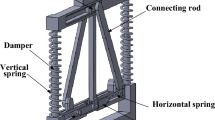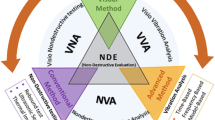Abstract
Output-only modal identification or operational modal analysis (OMA) has gained increasing popularity in many fields of engineering. In the context of OMA there is no need to measure the input. Modal parameters of dynamic systems are estimated just based on the output responses. One of the most robust and popular frequency domain methods of OMA is enhanced frequency domain decomposition (EFDD) method. EFDD is widely used as an interesting solution for OMA in a large number of researches, projects, and commercial software. We first assessed the EFDD features considering the design parameters selection and then introduced our recently proposed algorithm named in-operation modal appropriation (INOPMA) for use with EFDD method to improve the identification of modal frequencies and damping ratios and overcome some of the existing drawbacks. Modal identification process starts with EFDD and then INOPMA is applied on derived normalized auto-correlation functions (NACF) to estimate modal damping ratios and natural frequencies. Typical EFDD takes advantage of logarithmic decrement (LD) algorithm and zero crossing (ZC) method at this stage. A simulated four-story shear frame has been employed to perform the evaluation of the proposed method on output-only prediction of ideal natural frequencies and modal damping ratios. The outcomes show that the modal parameters are estimated with much less bias error and variance compared to the typical EFDD procedure. The real data of the heritage court tower ambient vibration test is also used to perform sensitivity analysis of EFDD-INOPMA modal parameter estimation in the presence of measurement noise, and favorable results have been obtained.
Similar content being viewed by others
References
G. H. James, T. G. Crane and J. Laufer, The natural excitation technique (NExT) for modal parameter extraction from operating structures, The International J. of Analytical and Experimental Modal Analysis, 10 (1995) 260–277.
L. Ljung, System Identification: Theory for the User, Second Ed., Prentice Hall, Upper Saddle River, New Jersey, USA (1999).
P. Van Overschee and B. De Moor, Subspace algorithms for the stochastic identification problem, Automatica, 29 (3) (1993) 649–660.
F. Poncelet, G. Kerschen, J.-C. Golinval and D. Verhelst, Output-only modal analysis using blind source separation techniques, Mechanical Systems and Signal Processing, 21 (6) (2007) 2335–2358.
Y. Jin, S. Qin, J. Guo and C. Zhu, Output-only modal identification based on hierarchical Hough transform, J. of Mechanical Science and Technology, 30 (7) (2016) 2941–2951.
A. Farzampour, A. Kamali-Asl and J. W. Hu, Unsupervised identification of arbitrarily-damped structures using time-scale independent component analysis: Part I, J. of Mechanical Science and Technology, 32 (2) (2018) 567–577.
D. J. Ewins, Modal Testing, Theory, Practice, and Application, 2nd Ed., Research Studies Press, Baldock, England (2000).
R. Brincker, L. Zhang and P. Andersen, Modal identification from ambient responses using frequency domain decomposition, Proc. 18th IMAC, San Antonio, Texas (2000).
R. Brincker, C. Ventura and P. Andersen, Damping estimation by frequency domain decomposition, Proc. 19th IMAC, Orlando, Florida (2001).
P. Verboven, Frequency-domain System Identification for Modal Analysis, Ph.D. Thesis, Vrije Universiteit Brussels, Brussels (2002).
P. Guillaume, P. Verboven, S. Vanlanduit, H. Van der Au-weraer and B. Peeters, A poly-reference implementation of the least-squares complex frequency-domain estimator, Proc. 21st IMAC, Kissimmee, Florida (2003).
C. Devriendt and P. Guillaume, The use of transmissibility measurements in output-only modal analysis, Mechanical Systems and Signal Processing, 21 (7) (2007) 2689–2696.
J. Rodrigues, R. Brincker and P. Andersen, Improvement of frequency domain output-only modal identification from the application of the random decrement technique, Proc. 22nd IMAC, Dearborn, Michigan (2004).
N.-J. Jacobsen, P. Andersen and R. Brincker, Applications of frequency domain curve-fitting in the EFDD technique, Proc. 26th IMAC, Orlando, Florida (2008).
L. Zhang, T. Wang and Y. Tamura, A frequency-spatial domain decomposition (FSDD) method for operational modal analysis, Mechanical Systems and Signal Processing, 24 (5) (2010) 1227–1239.
F. Pioldi and E. Rizzi, Refined frequency domain decomposition modal dynamic identification from earthquake-induced structural responses, Meccanica, 52 (13) (2017) 3165–3179.
F. Pioldi, R. Ferrari and E. Rizzi, Output-only modal dynamic identification of frames by a refined FDD algorithm at seismic input and high damping, Mechanical Systems and Signal Processing, 68–69.(2016) 265–291.
M. Ghalishooyan and A. Shooshtari, Operational modal analysis techniques and their theoretical and practical aspects: A comprehensive review and introduction, Proc. 6th IOMAC, Gijón, Spain (2015).
M. Basseville, M. Abdelghani and A. Benveniste, Sub-space-based fault detection algorithms for vibration monitoring, Automatica, 36 (1) (2000) 101–109.
S. E.-O. Bahlous, M. Abdelghani, H. Smaoui and S. El-Borgi, A modal filtering and statistical approach for damage detection and diagnosis in structures using ambient vibrations measurements, J. of Vibration and Control, 13 (3) (2007) 281–308.
M. Domaneschi, M. P. Limongelli and L. Martinelli, Damage detection and localization on a benchmark cable-stayed bridge, Earthquakes and Structures, 8 (5) (2015) 1113–1126.
M. Abdelghani and D. J. Inman, Modal appropriation for use with in-operation modal analysis, Shock and Vibration, 2015 (ID 537030) (2015).
L. Meirovitch, Elements of Vibration Analysis, McGraw-Hill (1986).
M. Abdelghani, M. Ghalishooyan and A. Shooshtari, A comparative assessment of in-operation modal analysis and frequency domain decomposition algorithm using simulated data, Advances in Acoustics and Vibration, Springer (2017) 215–221.
R. Brincker and C. Ventura, Introduction to Operational Modal Analysis, Wiley, USA (2015).
C. Dyck and C. Ventura, Ambient Vibration Measurements of Heritage Court Tower, Research report No. 98-007. EQ LAB, University of British Columbia, Vancouver, Canada (1998).
J. Antoni and J. Schoukens, A comprehensive study of the bias and variance of frequency-response-function measurements: Optimal window selection and overlapping strategies, Automatica, 43 (10) (2007) 1723–1736.
D. F. Giraldo, W. Song, S. J. Dyke and J. M. Caicedo, Modal identification through ambient vibration: Comparative study, J. of Engineering Mechanics, 135 (8) (2009) 759–770.
B. K. Jung, J. R. Cho and W. B. Jeong, Sensor placement optimization for structural modal identification of flexible structures using genetic algorithm, J. of Mechanical Science and Technology, 29 (7) (2015) 2775–2783.
Author information
Authors and Affiliations
Corresponding author
Additional information
Recommended by Associate Editor Daeil Kwon
Morteza Ghalishooyan is a Ph.D. candidate in Civil Engineering at Ferdowsi University of Mashhad. His current research interests include structural dynamics and modal identification of structures.
Ahmad Shooshtari received the Ph.D. in Civil Engineering from University of Ottawa, Canada. He is an Associate Professor in the Department of Civil Engineering at Ferdowsi University of Mashhad, Iran.
Rights and permissions
About this article
Cite this article
Ghalishooyan, M., Shooshtari, A. & Abdelghani, M. Output-only modal identification by in-operation modal appropriation for use with enhanced frequency domain decomposition method. J Mech Sci Technol 33, 3055–3067 (2019). https://doi.org/10.1007/s12206-018-0906-1
Received:
Revised:
Accepted:
Published:
Issue Date:
DOI: https://doi.org/10.1007/s12206-018-0906-1




